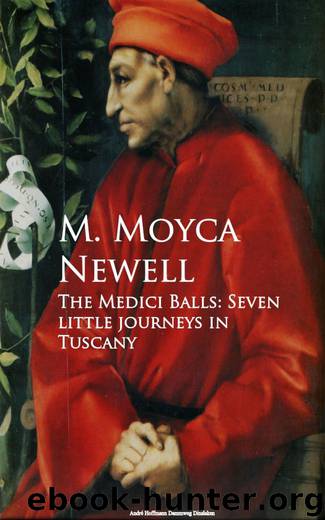The Medici Balls: Seven little journeys in Tuscany by M. Moyca Newell

Author:M. Moyca Newell [Newell, M. Moyca]
Language: eng
Format: epub
Published: 2016-09-06T22:00:00+00:00
Alinari Giorgione
MADONNA AND CHILD, WITH TWO SAINTS
PAROCHIAL CHURCH. CASTELFRANCO
Hanfstaengl Botticelli
PORTRAIT OF A YOUNG FLORENTINE
ROYAL GALLERY, BERLIN
It is impossible to compare Castruccio exactly with any other free-lance of his time. There are condottieri and condottieri ; the range is so wide and, defining lines so elastic that in the day when individuality was more marked than in any other period of the world's history, it is not strange to find in the same class such widely differing characters as Francesco Sforza, called the "great Condottiere," the brave and skillful but humane Carmagnuola, or the youthful Matteo Costanzo, who, in full armour and bearing the standard of the cross, figures as San Liberale in Giorgione's celebrated Castelfranco Madonna and Child. Matteo died young, but had been trained as condottiere by his father, who gave Giorgione's Madonna to the Church, as a votive offering in memory of his lamented son. There was no bronze statue raised in Castruccio's honour, and no portrait of him is mentioned, though it is said he appears in Benozzo Gozzoli's Procession of the Magi in the Riccardi Palace, and in Orcagna's Triumph of Death in the Campo Santo of Pisa. Of his personal appearance, therefore, we are wholly ignorant, except for the tradition that he had red hair. Nor are we much more certain of his youth and training. Machiavelli's romantic account relates that he was a foundling, picked up in her vineyard by the kindly Dianora Castracane, of Lucca, who carried the infant home, and, calling her brother, a canon of San Michele, with whom she shared her house, tried to determine the child's future. After much discussion it was decided to give him the name of Castracane and educate him for the Church; but, though quick to learn, Castruccio had no taste or desire for the cloister; his one thought was for athletic sports, adventure, and the noble art of war. Playing with his fellows in the Piazza of San Michele, he attracted the attention of a nobleman of Lucca, who, when Castruccio was eighteen, adopted him, trained him to arms, and, upon his death, confided to him the care of his estates and direction of his only son. His masters in war were the most notable military leaders of the time, and "Machiavelli goes to the length of saying that, as a general, he was not inferior to Philip of Macedon, or Scipio." [9]
The more sober historians hold that Castruccio was a member of the Interminelli family, who had been exiled in his youth, and gained much military experience in England when serving under Edward I. All accounts agree that he was a remarkable man, and one critic writes of him thus: "Not only as a soldier but as a statesman he was undoubtedly the foremost man in Italy, and it is not improbable that, had he lived, he would have subjugated the whole peninsula."
Download
This site does not store any files on its server. We only index and link to content provided by other sites. Please contact the content providers to delete copyright contents if any and email us, we'll remove relevant links or contents immediately.
Beautiful Disaster by McGuire Jamie(25254)
Trainspotting by Irvine Welsh(21520)
Call Me by Your Name by André Aciman(20376)
The Secret History by Donna Tartt(18852)
All the Missing Girls by Megan Miranda(15587)
Cat's cradle by Kurt Vonnegut(15189)
Pimp by Iceberg Slim(14398)
Norse Mythology by Gaiman Neil(13211)
The Tidewater Tales by John Barth(12609)
4 3 2 1: A Novel by Paul Auster(12289)
Scorched Eggs by Childs Laura(11314)
The Break by Marian Keyes(9309)
Adultolescence by Gabbie Hanna(8859)
The remains of the day by Kazuo Ishiguro(8828)
Never let me go by Kazuo Ishiguro(8714)
Where the Crawdads Sing by Delia Owens(8522)
All the Light We Cannot See: A Novel by Anthony Doerr(8435)
A Man Called Ove: A Novel by Fredrik Backman(8373)
Circe by Madeline Miller(8020)
